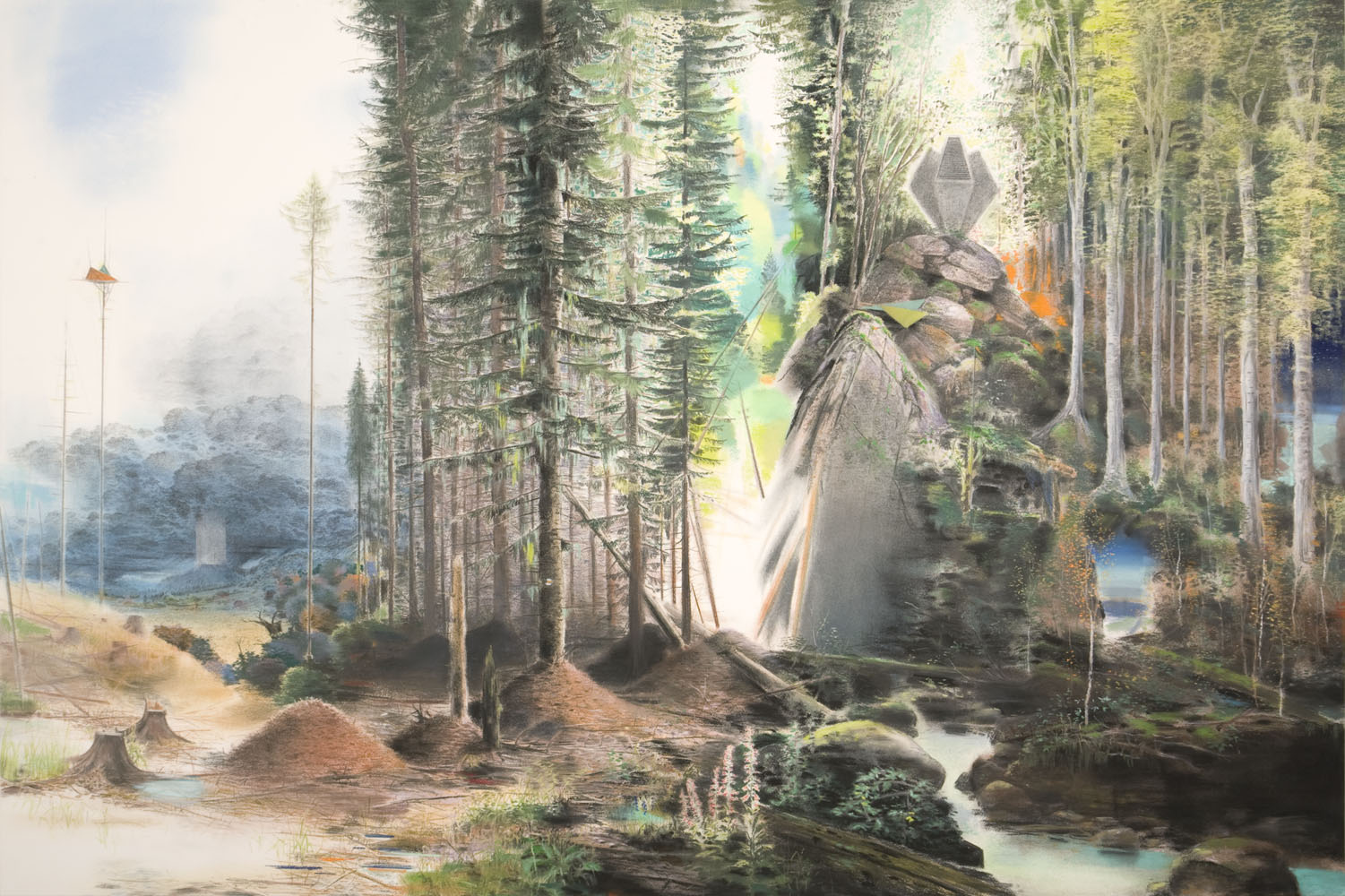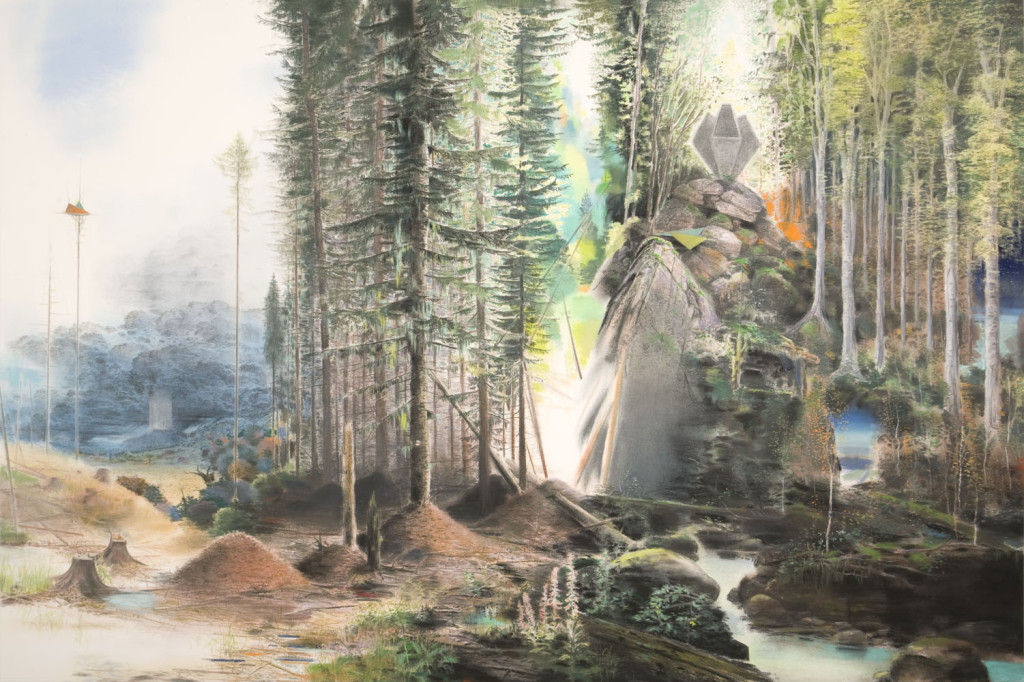What do we want now? What might our futures look like? Now, possibly more than at any time in the last twenty years, these are the two questions at the heart of contemporary thinking. The world is in recession. Over the past year, London has seen inflation, unemployment, protests on an almost monthly basis, and some of the worst rioting in memory. But the problems are not simply economic: there’s a sense of decay, of something rotten at the very centre of our proudest institutions. The press, the police, Parliament, Whitehall: no longer do they form a delicate balance of productively conflicting power structures, but instead a homogeneous mass of incompetence and unpunished criminality. It’s hardly surprising then that today’s artists are responding to this bleak present with works that think about our possible futures.
January alone has seen three of London’s newer and more interesting commercial galleries open exhibitions that, more or less explicitly, explore ideas around the future as a projected ideal or fantasy. It’s certainly the right time of year – after the retrospective pontificating of December, January is traditionally a time for starting afresh and looking ahead.
What’s interesting, however, is that while politicians and the media espouse or oppose change on the basis of the immediately ensuing future, artists are persistently putting this logic into question. To some extent, any question of reform – any re-evaluation of what we now want – necessitates a vision of an ideal future, some kind of utopian projection. But it’s a necessity fraught with difficulty. Breese Little’s current exhibition, ‘Back to the Future’, explores the idea that we might have to look back as much as we look forward; whilst at Edel Assanti, Gordon Cheung curates a group show entitled ‘Immortal Nature’ that examines erroneous past predictions about the end of the world. In both cases, the works on show ironise the past’s conceptions of the future, thereby implicitly putting into question not only the accuracy but also the purpose of our own hopes and assumptions about the future.
The Future’s History
One show in particular traces this logical difficulty back to what one might hesitantly term its origin: Thomas More’s vastly influential, and ceaselessly strange ‘Utopia’. First published in 1516, the book divides into two sections – the first a series of fictional letters between real contemporary figures, the second an account of a journey to a mystical island and an exploration of its social mores. With its multiple framing devices the text is a kind of hall of mirrors – constantly undercutting itself with layers of irony and ambiguity. The very title – Utopia – is a neologism that stems from the Greek word ‘topos’ (meaning ‘place’) combined with a conflation of two prefixes: ‘eu’ (meaning ‘good’ or ‘well’) and ‘ou’ (meaning ‘no’). So, right at the origin of the very concept of utopia, is an equivocation. Utopia is always, to borrow a phrase from Wordsworth, “something evermore about to be”.
This is exactly what the current exhibition at Hoxton Art Gallery is examining. Entitled appropriately ‘Utopia’,onversations; and the space-age aesthetic of David Jones’ paintings. Head of Gallery, Lydia Cowpertwait stresses the labour-intensive nature of the works on show – something which characterises the works at Edel Assanti and Breese Little too. “People are starting to value craftsmanship again,” she says, “and things that are handmade rather than mass-produced.” The branded corporate take-over that accompanied the boom years is being replaced by a privileging of the local and the sustainable, as people begin to “go against society’s consumerist grain”.
Modernity in Ruins
Of particular relevance are the paintings and drawings of German-born artist Wieland Payer. Shrouded in a veil of nostalgia, these works portray the future as it may once have been imagined: monumental architectural structures discovered decaying in exotic jungles. As Cowpertwait explains: “Payer deals with the concept of Utopia in the most literal sense. The artist depicts explorers travelling through vast landscapes with peculiar Brutalist-like structures rising above wild fantastical forests.”
The presence of this kind of architecture is no coincidence. As Payer says himself: “There is a strong link between utopian ideals and the architecture of the 1930s through to the 1970s – Art Deco, International Style, Brutalism. Subsequently architecture lost this spirit, or so it seems to me.”
It is exactly this spirit and its subsequent loss that lies at the heart of today’s attempts to think around the idea of Utopia. With the failure of the Modernist project came Postmodernism’s rejection of any utopian spirit, and any thinking about the future was simply ironised to extinction. Modernism saw only Eutopia – the good place that justified the twentieth century’s worst atrocities – whilst Postmodernism saw only Outopia – no place that could exist, an illusion, a promise false from the start. Each view is as limited as the other; now is the time to move beyond such oppositions.
Back to the Future
But, first, it’s important to point out that the dream of a better future is nothing new; nor are the limitations of that dream. As Cowpertwait observes, “The concept of Utopia has taken many forms, whether being discussed in political philosophy, science fiction or even the Bible.” At the same time, the idea of Utopia has lent itself well to satire – from Samuel Butler’s ‘Erewhon’ to Orwell’s ‘Animal Farm’ and ‘1984′. In the seventeenth century, Milton and Marvell both explored Eden’s self-contradictions whilst Nicolas’ Poussin’s repetition of the phrase ‘Et in Arcadia Ego’, etched in stone, serves a similar function. Even in Arcadia, death is here.
What is new though is the framing of the discussion. The question today is how to talk about Utopia – how to think about a better future, about the changes that could take us there – without resort either to Modernism’s didactic idealism or the apathetic sneer of Postmodernity. One might look to the works of John Stark for a possible answer. Similar in some ways to Ged Quinn, David M Price and Katie Sims, Stark’s paintings depict landscape as something pre-modern, the timelessness of which echoes the title of Edel Assanti’s Immortal Nature. But Stark’s is a landscape rich in open-ended symbolism, as the works directly confront the problems of both Modernism and Postmodernism.
For Stark, utopia “is always and only an abstract concept driven by the idea of progress and the fear of what the future holds.” But today especially it’s also a concept that is both necessary and unavoidable: it is Jacques Derrida’s notion of the “democracy to come”, the performative promise that we all must share in.
Vantage Points
The interesting thing – and it’s the problem of any attempt to write about the now – is the inability to find a vantage point. Stark agrees that “many artists are dealing with utopian ideals born from science fiction narratives and looking back to a lost time of how we thought the future would be.” This kind of approach is clear from the retro-futurist aesthetic evident in works by Rowena Hughes and Viktor Timofeev at Breese Little’s show; in Gordon Cheung’s juxtaposition of Greek and Roman mythology with a kind of computer game aesthetic; and Jonah Freeman’s trompe l’oeil-images that imagine how classical civilisations of the past might have imagined the future to look like. That Freeman’s works take the form of digital prints made to look like fragments of ancient parchment makes a subtle point about our own assumptions. Just as the images of the future are rooted in the supposed time in which they were envisioned; so the artwork that created them is a product of contemporary technological innovation. We may feel superior to our predecessors but the present is always a prison.
Stark says something similar. Whilst he agrees that there is a concerted attempt to move beyond the Modernist/Postmodernist paradigm, he is also wary of hasty assumptions. “There is definitely a reformation going on,” he says, “but we can’t see it yet. There’s an unfathomable amount of information flying around and so much noise – maybe we’ll get a quiet spot in ten years or so and be able to look back and see where we went wrong, again.”
It is this consciousness of the inevitability of going wrong that separates today’s explorations of Utopia from Modernism, but a refusal to let that inevitability result in a sense of futility that defines a move away from Postmodernism. I think it’s in this that we can begin already to discern something – the shape of the argument to come perhaps.
The prognosis is still unclear. Whether capitalism is in crisis (as the FT pondered in January) or whether capitalism is crisis (as one banner at Occupy London’s St Paul’s camp has it), any thinking about today’s systemic problems necessitates a vision of how the future could look. Or rather, a series of visions: both Stark and Cowpertwait emphasise an allowance for individual concepts of utopia in a way prohibited by Modernism’s quest for purity.
But it’s not only about a liberal multiplicity of visions. Today’s artists are demanding and enacting a mode of critical thinking that analyses the very process by which such visions are produced. The present is the place to start this thinking. The perfect future starts with the future perfect: this is what will have been.
Tom JEFFREYS
‘Utopia’, till 1st of March at Hoxton Art Gallery, 64 Charlotte Road, Hoxton, London, UK.www.hoxtonartgallery.co.uk
‘Back to the Future’, till 3rd of March at Breese Little, 30d Great Sutton Street, London, UK.www.breeselittle.com
‘Immortal Nature’, till 3rd of March at Edel Assanti, 276 Vauxhall Bridge Road London, UK.www.edelassanti.com

